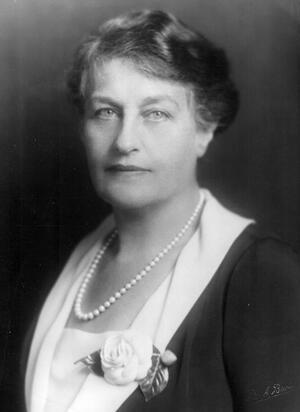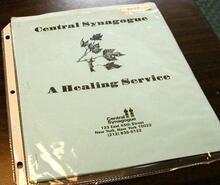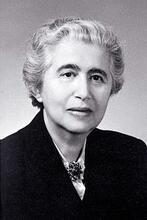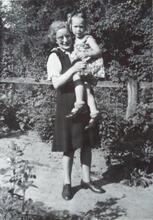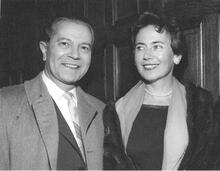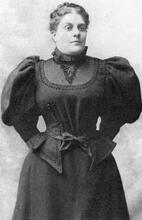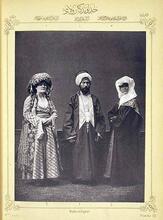Jewish Museums in the United States
American Jewish women have played an outsized role in the foundation of Jewish museums. Barred from traditional spaces of power in the early twentieth century, many women—adjacent to power as Rebbetzins (wives of rabbis), philanthropists (daughters and wives of major recognized philanthropists), and secretaries of libraries and other Jewish organizations—leveraged their connections to establish new kinds of cultural institutions: museums. The National Federation of Temple Sisterhoods was responsible for the founding of the first American Jewish museum at Hebrew Union College in Cincinnati in 1913, and in 1944 Frieda Schiff Warburg donated her neo-Gothic mansion to found the Jewish Museum in New York. Jewish women were also some of the first people to establish culturally specific museums, laying the groundwork for the “identity museum” movement of the last few decades.
Jewish women have often played prominent roles as founders, directors, curators, artists, and patrons of Jewish museums in the United States. Though men have also served in each of these capacities, women have been particularly critical and essential as creators and developers. Women were the visionaries who spearheaded the founding of Jewish museums in places as diverse as Cincinnati, New York, and Boston.
History
The first Jewish museum in the country was formalized in 1913, as an appendage to the Hebrew Union College (HUC) in Cincinnati. (Reorganized, it became the Skirball Museum in Los Angeles in 1972.) The Reform women’s organization headquartered there, the National Federation of Temple Sisterhoods, was responsible for its founding. Throughout its long history, the NFTS (renamed the Women of Reform Judaism in 1993) has worked to found Jewish museums in Reform synagogues around the country, even including in its bylaws that one of the five goals of each sisterhood should be the establishment of a Jewish museum in every synagogue.
Jewish museums emerged in several European cities over a short span of years in the late nineteenth century. Emancipation and Enlightenment resulted in the transformation of objects of traditional religious practice, intended for home or synagogue use, into artifacts for the display of Jewish culture. In the United States in the 1910s and 1920s, Anna Kleban, Secretary to the Librarian at the Jewish Theological Seminary, began collecting and displaying art objects in the JTS library; important figures continued to donate Judaica objects over the following several decades. In 1940, Rebbetzin Mignon Rubenovitz founded a Jewish museum in Boston attached to Mishkan Tefila, the synagogue where her husband Herman was a rabbi. In 1944, Frieda Schiff Warburg donated her neo-Gothic mansion at 92nd Street and Fifth Avenue in New York to found a Jewish Museum—the first independent address of Jewish art in America. Early donations at JTS, where Schiff Warburg was the first and only woman to serve on the board for several decades, formed the nucleus of this museum, and Anna Kleban was involved in its early curation.
By the time of the Holocaust, the NFTS, Frieda Schiff Warburg, and other noteworthy women had established the trend of forming repositories for Jewish objects. Several years after World War II, Jewish museums in America began to flourish and truly became mainstream. Other museums followed in the 1960s and 1970s.
Across the United States, the new recognition of the need to preserve and document Jewish culture, and through its interpretation to educate a new generation of Jews and non-Jews, motivated founders of Jewish museums. Notable are the B’nai B’rith Klutznick National Jewish Museum, established in Washington, D.C., in 1957; the Judah L. Magnes Museum, established in Oakland, California, in 1962 and later moved to Berkeley, California; the Spertus Museum of Judaica, established in Chicago in 1967; Yeshiva University Museum, established in New York City in 1973; and the National Museum of American Jewish History, established in Philadelphia, in 1976. Women have played an outsized role in directing and leading all of these institutions.
Along with the Jewish Museum in New York and the HUC Skirball Museum in Los Angeles, in 1977 these seven Jewish museums established the Council of American Jewish Museums (CAJM), which later received ongoing administrative support from the National Foundation for Jewish Culture. Membership was made available to other museums in 1987. By 2004, CAJM had grown to more than 75 member museums, including art and history museums, Jewish historic sites, historic and archival societies, Holocaust centers, synagogue museums, and galleries associated with Jewish community centers and universities; as if 2021, it had approximately 70 members. It has been led by a woman ever since. Synagogue museums and community center galleries represent over one-third of CAJM members. Representatives of many of these museums attend annual conferences and are involved in other programmatic activities.
In October 2000, five institutions combined their holdings to form the Center for Jewish History in New York City, an amalgam of the American Jewish Historical Society, American Sephardi Federation, Leo Baeck Institute, Yeshiva University Museum, and the YIVO Institute for Jewish Research that is now the largest repository of Jewish documentation outside Israel.
Women and Jewish Museums
There are many explanations for the contributions of women to the development of Jewish museums. Select few Jewish women served on the boards of secular museums in major cities, but they could have only limited impact because they were both women and Jews. Some women learned about philanthropy through fathers and husbands involved with institutions such as JTS and HUC; and in some cases they were even able to sit in on board meetings without being recognized as board members. Frieda Schiff Warburg was an anomaly as the only woman on the JTS board starting in 1938 (the death of her board-member husband created a vacancy, and her father was almost single-handedly responsible for the survival of JTS through the Great Depression).
Barred from traditional spaces of leadership in the Jewish community, early twentieth-century women sought ways to make a meaningful imprint on Jewish life in America in some alternative way. By founding Jewish museums, such women created an alternative path for philanthropy that allowed them to organize women to further a new cause. By the time of the Holocaust, women had established Jewish museums and continued pursuing leadership roles within them. Jewish museums in the postwar period offered women opportunities for recognition not attainable in other fields. In recent decades, as professional areas such as the rabbinate and cantorate have opened to women, and as academic opportunities at university levels have expanded, women have remained involved at Jewish museums. It is notable that the Jewish Museum in New York has been predominantly led by women since the 1970s.
More recently, Jewish museum work has been professionalized. Although the academic field of Jewish art was advanced in pre-Holocaust Europe, its American version was not advanced until Rachel Wischnitzer, former curator of the Berlin Jewish Museum, began teaching at Stern College for Women of Yeshiva University in New York City, at age seventy-one. During a twelve-year span, she served as a role model and inspiration to several generations of students at Stern College. Her writings and comments on Jewish art exhibitions remain some of the best writing about Jewish art in existence.
During Wischnitzer’s time, access to Jewish arts education remained rare until the development of Jewish studies programs in the 1970s and beyond. Many leading Jewish museum professionals trained in related art fields. Olga Weiss, curator of exhibitions at the Spertus Museum of Judaica, worked as a volunteer before earning a master’s degree in art history. Susan Goodman studied primitive art, beginning her career at the Guggenheim Museum and later joining the staff of the Jewish Museum, where she serves as chief curator. Female leadership at both these institutions encouraged Goodman’s professional development. Samantha Baskind, a professor at Cleveland State University, laments that in order to study Jewish art, she had to find a work-around by applying for a PhD in the related field of American art; today she lectures and writes about this dearth of professional and scholarly opportunity in the field and explains that the situation is changing.
Only recently have more options been offered for serious training in the arts, Jewish studies, and education. Vivian Mann, who once held the Morris and Eva Feld Chair of Judaica at the Jewish Museum and was the foremost scholar of Jewish art in the United States after Wischnitzer, also directed the first master’s program in Jewish art and material culture. In the first year of the program (1994–1995), twelve of fourteen students were female. Joint studies at the Jewish Theological Seminary of America, Columbia University, and the Jewish Museum are now creating a new professional standard for future generations of Jewish women museum professionals. Vivian Mann’s student Lauren Strauss recently published a book about Jewish activist artists, and Warren Klein, another of Mann’s students, is the art curator at the Reform Temple Emanu-El in New York City.
The early twentieth-century pattern of women building, creating, and developing Jewish museums lingers today. In 1997, some eighty percent of Jewish museum directors were women. Joy Ungerleider-Mayerson directed the Jewish Museum in the 1970s, later becoming a strong patron of Jewish arts worldwide through the Dorot Foundation. Joan Rosenbaum, who succeeded her in 1980, brought the museum international recognition, guiding a major expansion project in 1992. Under their leadership, the Jewish Museum presented exhibitions that extended far beyond ritual objects and transformed the museum into a center for the study of contemporary art, history, and culture as interpreted in Jewish life. Other museum directors have continued this pattern. Sylvia Herskowitz, longtime director of the Yeshiva University Museum, nurtured the museum through a period of growth and accomplishment. For many years Margo Bloom developed and displayed a number of analytical social history exhibitions at the National Museum of American Jewish History in Philadelphia. Anna Cohn spearheaded the evolution of the B’nai B’rith Klutznick National Jewish Museum from a gallery installation to a substantial exhibition facility. She later developed the Precious Legacy Project, a traveling exhibit of Judaica collected at Prague from destroyed Czech and Slovak Jewish communities, and then served as the first director of museum planning for the U.S. Holocaust Memorial Museum. Rebecca Fromer and Ruth Eis played extraordinary roles in the establishment and collection development of the Judah L. Magnes Museum. Nancy Berman, formerly curator at the Jewish Museum, transformed the Skirball Museum after 1972, leading to the 1996 opening of the Skirball Cultural Center. Women continue to lead institutions: Carole Zawatsky is the founding director of the Maltz Museum of Jewish Heritage in Beechwood Ohio, which opened in 2005.
Curators
Grace Cohen Grossman, curator at the Skirball Museum, advanced cataloging of Judaica at the Smithsonian Institution as research collaborator for the National Museum of American History. Her other achievements include the core exhibition and Project Americana of the Skirball Museum and the publication of the comprehensive Jewish Art (1995) and Jewish Museums of the World (2003).
Working in other repositories, such as the JTS library, Evelyn Cohen pioneered the creation of a new Jewish Art Department. Sharon Liberman Mintz continued this work, which resulted in an extensive collection and exhibition program relating to all aspects of the Hebrew book, manuscripts, and related art objects.
Collectors and Patrons
Jewish museums bear testimony to the husbands and wives who have collected Judaica together, and who have, in many cases, made considerable financial contributions. A few donors stand out in generously shaping museums. Frances Pascher and her husband Abram Kanof established the Tobe Pascher Workshop at the Jewish Museum as a studio center for the creation of Jewish ceremonial art; Erica Pappenheim Jesselson and her husband, Ludwig Jesselson, have long been identified as the patrons of the Yeshiva University Museum; and Audrey Skirball Kenis, with her support of the new Skirball Cultural Center and Museum, has continued Jack Skirball’s vision of a new kind of cultural and educational entity to reinforce Jewish identity.
Educators
Jewish museums have transformed themselves from repositories to vital centers of Jewish education and identity formation. Esther Netter, of My Jewish Discovery Center, targeted assimilated Jews and intermarried families through a series of traveling exhibitions. Adele Lander Burke, of the Skirball Museum, developed the groundbreaking MUSE program, which uses ethnographic approaches to compare ceremonial objects among diverse cultures. Judith Siegel, for many years director of education at the Jewish Museum, helped develop programs for Bridges and Boundaries, an exhibition exploring Jewish and African-American identities.
Docents
Volunteers continue to play a significant role in Jewish museums. Women have predominated as docents, conducting tours and programs. Most of each of the above are women. In recent years, there has been a slight yet notable shift toward male retirees whose volunteer efforts mark a search for a fulfilling experience, while new, full-time career opportunities have been made available to women.
Synagogue Museums
Since the 1970s, a growing number of synagogue Judaica collections have been made accessible through the establishment of interpretive exhibitions and the creation of gallery space. For the most part, these small museums are projects developed and run by women from congregations or their sisterhoods. Collections range in size from a few pieces in a showcase to several rooms.
Other stand-alone museums have developed their own shows by taking an interpretive approach to their donor-created collections. The Sylvia Plotkin Judaica Museum in Phoenix, Arizona, the Temple Judea Museum of Keneseth Israel in Elkins Park, Pennsylvania, and the Mizel Museum of Judaica in Denver, Colorado, are a few such museums.
With the publication of A Temple Treasury: The Judaica Collection of Congregation Emanu-El of the City of New York, by Reva Goodlove Kirschberg and Cissy Grossman, the collection of New York’s Congregation Emanu-El has also become well known. The Herbert and Eileen Bernard Museum includes both the functional objects formerly used in the synagogue and a formal collection inaugurated in 1928, when the present building at Fifth Avenue and 65th Street was erected. Cissy Grossman, curator of the collection, has also developed numerous Judaica exhibitions as assistant curator at the Jewish Museum and as curator of the collection at New York City’s historic Central Synagogue collection.
In addition to the numerous synagogues whose buildings have landmark status, significant collections include the Congregation Beth Ahabah Museum and Archives Trust, in Richmond, Virginia, and the Dr. Edgar R. Cofeld Judaic Museum of Temple Beth Zion, in Buffalo, New York. The Elizabeth S. Fine Museum at Congregation Emanu-El, in San Francisco, bears the name of the wife of longtime rabbi Alvin Fine, while the Janice Charach Epstein Museum Gallery of the Jewish Community Center of Metropolitan Detroit bears the name of this young artist, also in memoriam. The mission of this gallery is to show and support the work of young Jewish artists.
Conclusion
The traditionally strong presence of women in the Jewish museum field has shaped and defined the scope and influence of these institutions. Women make enormous contributions as builders of institutions. Yet their strong presence fails to give museums priority of place for Jewish communal budgets, where museums struggle to carve their identity against a backdrop of more pressing social service demands. Consequently, even today, Jewish museums still occupy a modest position in the Jewish communal roster. Perhaps in part because women direct them, Jewish museums are compelled to continue to struggle to achieve even a modest degree of visibility within the philanthropic community.
Nonetheless, Jewish museums have played an enhanced role in recent decades as educational and cultural centers, as well as sources of preservation and documentation of significant historical events. Their ability to recognize the changing social and religious needs of their communities assures both an important and vibrant future for these institutions. Furthermore, Jewish women were some of the first people to establish culturally specific museums, and the “identity museum” movement, as it has been subsequently named, led to the National Museum of the American Indian, the National Museum of African American History in Washington, D.C., and many more. Even if Jewish museums are no longer the centerpiece of the identity museums of our country, they were the first—thanks to Jewish women.
AJYB 91 (1991), s.v. “American Jewish Museums: Trends and Issues”.
Balin, Carole, Dana Herman, Jonathan Sarna, and Gary Zola, eds. Sisterhood: A Centennial History of Women of Reform Judaism. Cincinnati, Ohio: Hebrew Union College Press, 2013.
Bilski, Emily D. “The Art of the Jewish Museum.” In The Jewish Museum New York, edited by Vivian B. Mann and Emily D. Bilski. New York: Scala Books, Jewish Museum, 1993.
Cohn-Wiener, Ernst. Jewish Art: Its History from the Beginning to the Present Day. Yelvertoft Manor, Northamptonshire: Pilkington Press LTD, 2001.
Glaser, Jane R., and Artemis A. Zenetou. Gender Perspectives: Essays on Women in Museums. Washington, DC: Smithsonian Institution Press, 1994.
Greenwald, Alice. “Jewish Museums in the U.S.A.” EJ Yearbook (1988–1989): 167–181.
Grossman, Cissy and Reva Goodlove Kirschberg. A Temple Treasury: The Judaica Collection of Congregation Emanu-El of the City of New York. New York: Hudson Hills Press, Congregation Emanu-El of the City of New York, 1989.
Grossman, Grace. Jewish Art. London: Hugh Lauter Levin, 1995.
Siegel, Judith. Conversation with author Karen Franklin, December 1995.
Silver, Larry, and Samantha Baskind. Jewish Art: A Modern History. London, England: Reaktion Books Ltd, 2011.
Van Voolen, Edward. “Jewish Museums in Europe.” EJ Yearbook (1988–1989): 182–188.
Zemel, Carol. Looking Jewish: Visual Culture and Modern Diaspora. Bloomington, Indiana: Indiana University Press, 2015.

